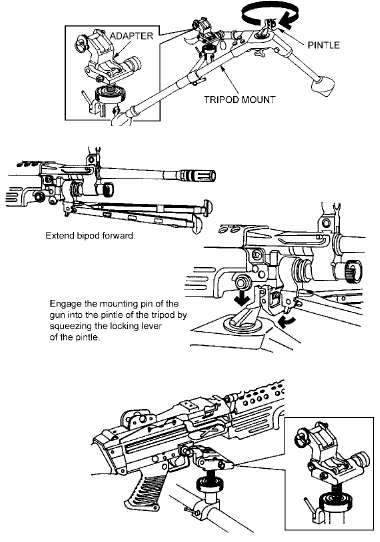M122 Tripod
The M122 tripod provides a stable mount for the M249, and it permits a higher degree of accuracy and control. The tripod is recommended for all marksmanship training and defensive employment.
Mounting the M122 Tripod. The tripod assembly provides a stable and relatively lightweight base that is far superior to the bipod. The tripod may be extended and collapsed without difficulty. It consists of a tripod head, one front leg and two rear legs, and traversing bar. The traversing bar connects the two rear legs. The traversing bar is hinged on one side with a sleeve and sleeve latch on the other. This procedure allows the tripod to collapse to a closed position for carrying or storage, or to lock in an open, extended position for use. The traversing bar also supports the T&E mechanism. Engraved on the bar is a scale, which measures direction in mils. It is graduated in 5-mil increments. It is numbered every 100 mils to 425 mils right of center, and it is numbered every 100 mils to 450 mils left of center.
(1) The T&E mechanism provides controlled manipulation and the ability to engage predetermined targets.
(a) The traversing portion of the mechanism consists of the traversing handwheel and traversing slide-lock lever. As the traversing handwheel is turned, the muzzle of the weapon will turn to the left or right, depending on the direction it is turned. Each click of the traversing handwheel indicates a 1 mil change in direction of the muzzle: 1 click equals 1 mil. There is a total of 100 mils traverse (50 mils right and 50 mils left of center).
(b) The elevating portion of the mechanism consists only of the elevating handwheel. The elevating handwheel has a mil-click device built into it (1 click equals 1 mil). Engraved into the handwheel is a scale divided into 5-mil divisions and 1-mil subdivisions, for a total of 50 mils increments. There are 200 mils above and 200 mils below the zero mark ,for a total of 400 mils in elevation change. Elevation readings are taken in two parts. First, the major reading is taken from the elevation screw plate. The second, minor reading is from the handwheel. The two readings are separated by a slash (“/”) when they are recorded.
(c) The traversing slide-lock lever allows rapid lateral adjustments along the traversing bar. Direction readings are taken from the scale on the traversing bar, using the left side of the traversing slide as an index. The direction of the reading comes from the position of the muzzle, not the position of the slide.
(2) To set up the tripod, unfold the front leg and spread the rear legs until the leg lock engages. Insert the pintle assembly and rotate the pintle lock-release cam to lock. Ensure that the locking lever of the pintle is facing forward toward the front leg.
(3) Attach the traversing and elevating mechanism (which requires a special adapter). Ensure that the adapter pin is to the right and the opening between it is to the rear. Center the elevating and traversing handwheels. To do this, he rotates the elevation handwheel until about 1-1/2 inches (two fingers) are visible on the upper elevating screw; he rotates the traversing slide until about two fingers are visible on the lower elevating screw. He rotates the traversing handwheel towards his body as far as it will go, then turns it away two complete revolutions. He checks the traversing handwheel scale to ensure the “0” on the scale is aligned with the “0” index line before and after the two revolutions. The T&E is now roughly centered. At night, he positions the traversing mechanism by turning the traversing handwheel toward his body as far as it will go, and then turning it away 50 clicks (two revolutions).
(4) With the T&E roughly centered, he lowers the traversing slide on to the traversing bar with the locking lever to the rear, and the traversing handwheel to the left, and secures it by turning the locking lever clockwise.
(5) The weapon attaches to the M122 tripod. First, he extends the bipod legs forward. Then, he engages the mounting pins (Located between the front of the handguard and the bipod legs) of the M249 into the pintle of the tripod by squeezing the locking lever of the pintle. He lowers the rear of the weapon so that the hole above the trigger guard can be engaged with the locking pin of the T&E adapter. He aligns the hole with the pin of the adapter and pushes the pin from right to left to secure the M249 to the M122 tripod.
(6) After the M249 is attached and secured to the tripod, the gunner must attach a special ammunition adapter to the M249. He inserts the adapter into the magazine well, as if inserting a magazine. This procedure allows the gunner to use the 200-round drum of ammunition.

Tripod Mount
Dismounting The M249 From The M122 Tripod. The gunner dismounts the M249 from the tripod by first removing the traversing and elevation mechanism from the weapon. He pulls the locking pin of the adapter to release the T&E from the trigger guard. He grasps the carrying handle with his left hand and squeezes the pintle-locking lever with his right hand. He lifts the weapon from the pintle assembly and the tripod.